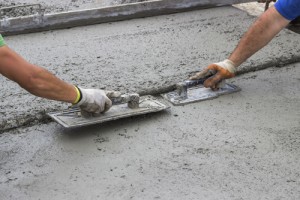One of the primary obstacles faced when installing a new concrete floor is moisture. While adding moisture to cement is a vital part of the process, but an excess of moisture results in problems with the slab and long drying times. To prevent additional moisture from entering concrete, vapor barriers are used before the concrete is poured. Here’s what you should know about these vapor barriers in order to use them effectively.
Adding moisture to a newly poured slab is relatively easy. It can be worked into the slab in a variety of ways and can make it more workable. However, the only way moisture escapes the slab is through evaporation on the slab’s surface. That means that in order to dry the slab effectively, additional moisture must be kept from entering it.
That’s where vapor barriers come into play. Not only are they responsible for protecting the slab from adhesive failures that occur due to an abundance of moisture, but they may also protect from common environmental problems in some circumstances, like mold and mildew growth. Vapor barriers can even help prevent harmful gases like radon and methane from penetrating your flooring.
In order to effectively use a vapor barrier, you first have to understand the difference between a barrier and a vapor retarder. This difference refers to the level of permeance of the product. Vapor retarders have a higher level of permeability, meaning they still allow moisture to pass through them. Vapor barriers are held to higher standards of permeability and while they may still allow some water vapor to pass through them, it’s typically significantly less than vapor retarders and so little that it won’t affect your slab.
To install a vapor barrier, apply it over a layer of granular fill. This will be most effective for preventing the wicking of ground moisture into your slab. Be sure all seams are properly sealed. Before the 2000s, a blotter layer was recommended to be laid on top of the vapor barrier, but that’s no longer necessary. Instead, your concrete slab can be poured directly on top of the barrier. Expect slower drying times with a vapor barrier in place because all moisture must move from the bottom of your slab to the surface and evaporate. The alternative is to lay the vapor barrier under the granular fill, which allows for faster drying as some of the moisture could be transferred to the fill. However, that often creates the possibility of that same moisture being absorbed back into the slab and creating problems.
In some situations, a second vapor barrier is needed on top of the finished concrete slab. For example, if a wood floor is to be laid on top of the concrete, a vapor barrier should be used in between to keep moisture from migrating from the slab to the porous flooring materials. Moisture will cause wood floors to crack and swell.
Local conditions and materials being used will help you decide when a vapor barrier is needed for your concrete installations.
At Maxwell Supply of Tulsa, we carry all the products you need for your concrete projects. Come see us to learn more about Xtreme Vapor Barrier or find it in our online store.
